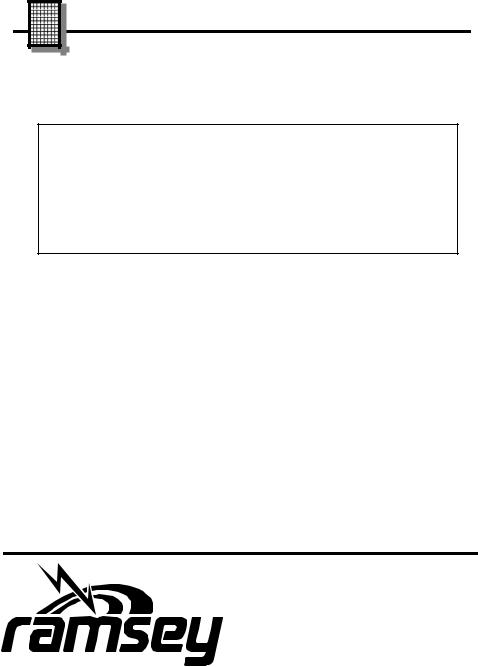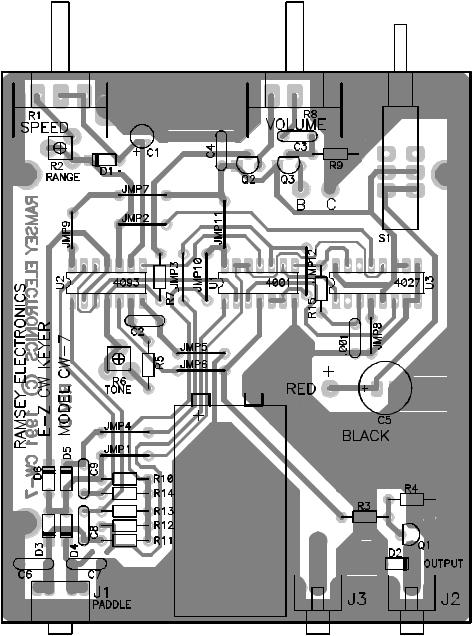Ramsey CW7 Manual
E-Z KEY CMOS
CW KEYER
Ramsey Electronics Model No. CW7
Add to your CW fun with this low cost keyer kit. You’ll send clean code that’s a pleasure to copy!
•Works great on any transmitter
•Built-in sidetone oscillator with pitch control
•Front panel volume and speed controls
•Clear, concise assembly instructions carefully guide you to a finished kit that works the FIRST time!
•Informative manual answers questions on theory, hook-ups and uses - enhances resale value too!
•Ideal companion to Ramsey QRP Transmitters
•Manual includes ideas on making your own keyer paddle!
•Runs on standard 9 volt battery
•Add our case and knob set for a finished ‘Pro’ look. Cases match all Ramsey products
SPECIAL NOTE TO HAM RADIO BEGINNERS:
Why settle for a code practice oscillator costing just as much as the Ramsey CW7 Keyer when you can learn perfect CW sending right from the start... and continue using the CW7 Keyer with your Ham rig!
CW7 • 1

PARTIAL LIST OF AVAILABLE KITS
RAMSEY TRANSMITTER KITS
•FM10A FM Stereo Transmitter
•MR6 Model Rocket Tracking Transmitter
•FM25B Synthesized FM Stereo Transmitter
•AM25 Synthesized AM Transmitter
• AM1 AM Transmitter
RAMSEY RECEIVER KITS
• FR1 FM Broadcast Receiver
• AR1 Aircraft Band Receiver
• AA7 Active Antenna
• SC1 Shortwave Converter
RAMSEY HOBBY KITS
• SG7 Personal Speed Radar
• SS70 Speech Scrambler
• TT1 Telephone Recorder
•SP1 Speakerphone
•MD3 Microwave Motion Detector
•PH10 Peak hold Meter
•LC1 Inductance-Capacitance Meter
RAMSEY AMATEUR RADIO KITS
•DDF1 Doppler Direction Finder
•HR Series HF All Mode Receivers
•QRP Series HF CW Transmitters
•VLF1 Low Frequency SWL Converter
•CPO3 Code Practice Oscillator
•QRP Power Amplifiers
RAMSEY MINI-KITS
Many other kits are available for hobby, school, scouts and just plain FUN. New kits are always under development. Write or call for our free Ramsey catalog.
CW7 CMOS CW KEYER KIT INSTRUCTION MANUAL
Ramsey Electronics publication No. CW7 Revision D
First printing: December 1991
COPYRIGHT 1994 by Ramsey Electronics, Inc. 590 Fishers Station Drive, Victor, New York 14564. All rights reserved. No portion of this publication may be copied or duplicated without the written permission of Ramsey Electronics, Inc. Printed in the United States of America.
CW7 • 2

Ramsey Publication No. CW7
Price $5.00
KIT ASSEMBLY |
AND INSTRUCTION MANUAL FOR |
CW7 E-Z CMOS
CW KEYER KIT
TABLE OF CONTENTS
Introduction to the CW7 ................. |
4 |
Parts list for the CW7 .................... |
6 |
Parts layout diagram ...................... |
7 |
Assembly instructions. ................... |
8 |
Schematic diagram ...................... |
12 |
Initial testing ................................. |
15 |
Adding options ............................. |
16 |
Transmitter connections............... |
17 |
Paddle information ....................... |
18 |
Making your own paddle .............. |
19 |
Warranty ...................................... |
23 |
RAMSEY ELECTRONICS, INC.
590 Fishers Station Drive
Victor, New York 14564
Phone (585) 924-4560 Fax (585) 924-4555 www.ramseykits.com
CW7 • 3
INTRODUCTION TO THE RAMSEY CW7
An "electronic keyer" generates the "dits" of the International Morse Code when the control paddle is touched to the right and the "dahs" when the paddle is touched to the left. Today, the electronic keyer is as standard and basic a way of sending the code as was the manual or "straight" key in past decades. In fact, due to the ever-higher costs of mechanical devices and the decreasing costs of modern electronics, it is possible to build or buy an electronic keyer more cheaply than many straight keys.
In fact, there is NO reason why amateur radio newcomers and licensed Novices should not start right out with an affordable electronic keyer, completely skipping any use of the manual keyer. Keyers are fun to use and help you develop an "ear" for well-formed characters. Neither the FCC nor volunteer examiners require proficiency with a manual code key. In fact, the actual testing procedure assumes that you CAN "send" and is concerned only with your ability to receive or copy the code.
Radio amateurs have been designing, building, using or buying "electronic keyers" for many decades. Even in the 1950's, very fine keyers could be built using only two small tubes and, ideally, a special mercury-wetted relay used in telephone switching circuits.
Today's CW keyer circuits can be as simple as one transistor and a relay, controlled by resistor-capacitor timing circuits, or quite elaborate with sophisticated micro-computer circuitry and numerous automatic memories for sending frequently-needed messages. Many modern transceivers have built-in keyers as optional or standard features. The authors of Solid State Design For the Radio Amateur tell us "designing keyer is an excellent mechanism for learning new circuit techniques. Even if the circuits are never built, it can be enlightening to go through the learning exercise of designing them" (ARRL, p. 178, 1986). These comments are in the context of showing a practical keyer using three 555 timer IC's, and the authors further state that the optimum keyer designs use CMOS ICs.
The Ramsey CW7 Keyer uses three 4000-series CMOS ICs in a reliable circuit featuring adjustable sidetone and comfortable speed control ranges. We have combined contemporary CMOS design, economy and practical operating features in a build-it-yourself keyer suitable for a wide range of CW keying applications. Our hope is that this basic or "first" keyer will be a reliable friend which you can understandand repair yourself if ever necessary, unlike the many mysterious and "dead" keyers we unearth at hamfests.
CW7 • 4
"KEYING YOUR KEYER"
One commercially-built mechanical CW device more costly than a manual or "straight" CW key is a set of "paddles" used to control electronic keyers. To our knowledge, the lowest-priced keyer paddle costs more than what you paid for this CW7 kit. For that reason, a detailed section on designing your "starter" CW keyer paddle is an important part of this book.
CW7 KEYER CIRCUIT DESCRIPTION:
U1, CMOS type 4001, is a quad 2-input NOR Gate device. U2, CMOS type 4093, is a quad 2-input NAND Schmitt Trigger Device. U3, CMOS type 4027, is a dual J-K Master-Slave Flip-Flop device.
Two of U2's NAND gates are configured as a latch to accomplish selfcompleting dits or dahs as soon as either side of the paddle device is touched.
A third NAND gate functions with R1, R2 and timing capacitor C2 as the dot clock, an adjustable 18-100 Hz clock oscillator. R1 is the front-panel CW speed control. Trimmer R2 is an internal "speed range" adjustment.
U3's J-K flip-flops [divide-by-1 (dit), divide-by-2 (space), divide-by-3 (dah)] generate correct, standard CW timing.
Two of U1's NOR gates drive Q1, the output switching transistor, which keys low-voltage solid-state transmitters or a relay. These gates also control the fourth U2 NAND gate as a sidetone oscillator, whose pitch is adjusted by R6. Q2 and Q3 amplify the sidetone for speaker operation. R8 gives front panel control of sidetone audio volume.
CW7 • 5

CW-7 KEYER KIT PARTS LIST
CAPACITORS:
3 .001 uF ceramic disc (marked .001,102 or 1nf) [C8,C9,C10]
3 .01 uF ceramic disc (marked .01,103 or 10 nf) [C4,C6,C7]
2 .1 uF ceramic disc (marked .1) [C2,C3]
1 4.7 uF tantalum [C1]
1 100 to 470 uF electrolytic [C5]
RESISTORS:
3 1K ohms (brown-black-red) [R3,R7,R9]
1 4.7K ohms (yellow-violet-red) [R15]
2 10K ohms (brown-black-orange) [R4,R5]
4 100K ohms (brown-black-yellow) [R10,R11,R12,R13]
1 330K ohms (orange-orange-yellow) [R14]
2 100K ohms PC-mounted trimmer pot [R2,R6]
1 10K ohms potentiometer [R8] (Sidetone volume)
1 100K ohms potentiometer [R1] (CW speed)
SEMICONDUCTORS:
6 1N914 or 1N4148 style signal diode [D1-D6]
3 2N3904 NPN Transistor [Q1,Q2,Q3]
1 CMOS IC Type 4001 [U1]
1 CMOS IC Type 4093 [U2]
1 CMOS IC Type 4027 [U3]
HARDWARE:
1 Printed circuit board
2 RCA PC-mount jacks
1 Miniature PC-mount stereo jack
1 DPDT push switch
1 9-volt battery snap connector
1 9-volt battery hold-down bracket
REQUIRED, NOT SUPPLIED:
1 9-volt alkaline battery
1 Standard miniature stereo plug for keyer paddle
1 Keyer paddle device of your choice
OPTIONAL, IF SIDETONE IS TO BE USED:
1 small speaker or earphones
CW7 • 6

CW7 PARTS LAYOUT DIAGRAM
CW7 • 7
KIT BUILDING TIPS:
Use a good soldering technique - let your soldering iron tip gently heat the traces to which you are soldering, heating both wires and pads simultaneously. Apply the solder on the iron and the pad when the pad is hot enough to melt the solder. The finished joint should look like a drop of water on paper, somewhat soaked in.
Mount all electrical parts on the top side of the board provided, unless otherwise specified. This is the side that has no traces or pads on it.
Electrical part installation - when parts are installed, the part is placed flat to the board, and the leads are bent on the backside of the board to prevent the part from falling out before soldering. The part is then soldered securely to the board, and the remaining lead length is clipped off.
ASSEMBLY INSTRUCTIONS:
We have a twofold "strategy" for the order of the following kit assembly steps. First, we install parts in physical relationship to each other, so there's minimal chance of inserting wires into wrong holes. Second, whenever possible, we install in an order that fits our "Learn As You Build" Kit-building philosophy.
FOR EACH PART OUR WORD "INSTALL" ALWAYS MEANS THESE STEPS:
1.Pick the correct part value to start with.
2.Insert it into the correct PC board location.
3.Orient it correctly, which means: Please follow the PC board and the written directions for all parts where there's a right way and a wrong way to solder it in. (Diode bands, electrolytic capacitor polarity, transistor shapes, dotted or notched ends of IC's, and so forth).
4.Solder all connections unless directed otherwise. Use enough heat and solder flow for clean, shiny, completed connections. Don't be afraid of any pen-style soldering iron having enough heat to damage components.
5.Trim or "nip" excess wire lengths after soldering.
CW7 • 8
